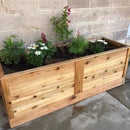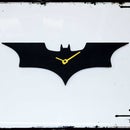Introduction: Cedar Barn Door
Introduction:
I made a thing and made this instructable so you can make a similar thing.
Materials:
- ~26 - Cedar Fence Slates
- 9 - 1" x 7" x 8' Cedar Planks
- Danish Oil
- Wood Glue
- Wood Putty
- Sand Paper 80 & 100 Grit
- Barn Door Hardware by Industrial By Design
Tools:
- Measuring Tape
- Square
- Jointer
- Planer
- Skil Saw
- Straight Edge
- Miter Saw
- Drill & Pocket Screw Jig
- Router
- Hand Saw
- Orbital Sander
- Clamps
These are the tools I used for the project because I have access to them. It does not mean you couldn't make a beautiful barn door with fewer or different tools.
I highly recommend the hardware from Industrial By Design. I am very happy with the quality of the product but even more impressed with the costumer service and the help I received from Wes.
Step 1: Plan
The dimensions of the doorway are 46 ¼" x 81".
I wanted to have at least a 2" overhang all around the door.
The width of the door I made to be 50 ½. This became a problem because the rail I bought after I designed the door was made to handle only a 50" wide door. With the help of Industrial By Design I was able to make it work but I recommend that you check the specs of your hardware before you design the door.
The height of the door is 82". This came from 81" (door height) - 1" (to clear carpet) + 2" (for top overhang)
The styles and rails are 6 ¾". I had planned on these being less wide but when I laid it out I decided I needed to double it up. Make your door your own!
The thickness of the door is 2". The hardware works with any thickness although you will need a header if it is too thick.
Using this equation from Industrial By Design you'll know if you need a header:
2 3/16" - (door depth) - (trim depth) - 3/16" (recommended gap from door to trim/wall)
If your answer is 0 or greater, then you're fine. If your answer was negative, then that number is the extra spacing you need. This extra spacing is accomplished by bolting a header board to the studs, and then the rail to this header board.
Step 2: Plane and Joint
Depending on the look and materials of your door you may be able to skip this step.
I wanted my door to have a nice finish so I needed to remove the years of weather from the cedar fence slats. With the help of my son we did most of that work with the planer. We only did 1 pass on each side so we didn't weaken the slats more than necessary.
Using the jointer, make the edges of the slats straight so they can be glued together to make the panels of the door.
Playing in the mess is essential.
Step 3: Layout
There is many different styles of barn door with slates usually going horizontal or vertical. I decided it would be more interesting to have my two panels running at 45 degrees meeting in the middle.
Cut the slats on the miter saw at 45 degrees, trimming the end (in my case until I got a piece that didn't fall apart because of cracks in the wood). I started at the top right corner and moved left until I passed 55 inches. Starting again at the top left corner flipping the board because 45 degrees + 45 degrees = 90 degrees. Place boards until the height is reached plus about 5" extra.
Leave the pieces long because when gluing it together there needs to be surface area to clamp the boards. The panels will be cut to length later when the panels are glued to the frame for an exact fit.
Step 4: Glue Panels
Gluing these together was a circus.
Before you add glue do a dry fit and make sure each joint is going to fit together with out any gaps, returning back to the jointer if necessary.
If you haven't all ready make sure to label each piece and maybe scribble on the joint where the two pieces align so there is less confusion as to how the puzzle goes together.
Glue the panels in sections. I broke the panel in half first, where they meet at 90°. Then broke each of those sections in two, gluing 3 or 4 slates at a time. Then I glued those pieces together so I had 2 halves. Finally gluing the halves together to make the panel.
When you glue try your best to keep the slats flush with each other. The more flush they are now the less sanding you'll do later.
Be sure you allow for enough dry time before trying to glue together the next section.
Getting clamps at some spots was difficult (I bet it is possible, not sure how though) so I used painters tape. Press firmly on one side of the joint and stretch the tape over the joint and press firmly on the other side.
Step 5: Cut Out Panels & Sand
Use the skil saw to cut rough size, leave 2-5 inches from the final measurements. (The router with make the final to length cut of the panels.)
Then, sand the panels, back and front. Start with 80 grit and finish with 100 grit. If your door is more rustic you may skip this step. Make sure that all the glue is sanded off or else it will show up when you put on the finish.
Square off the panels. The top edge of the bottom panel and the bottom edge of the top panel need to meet in the middle of the frame. Use the square and the edge of a slat to draw a line a couple times. Then use a straight edge to take that line across the panel.
Measure the distance from the guide on the skills saw to the blade. Then adding that distance from the line is where the straight edge needs to clamped down.
Because this edge will be covered by the frame if it is a little crooked it will be okay but it was easier to fit together straight. So if you don't have a straight edge, take your time and do your best.
Step 6: Build Frames
You will need a front and a back frame.
Unlike the panels make the frame to exact measurements. It will be used as a guide to cut the panels.
Use the miter saw to make 4 stiles (long) and 6 rails (short) to make both frames.
In all of the rails make 4 pocket holes (2 at each end) on the backside of your wood to attach to the stiles.
On the stiles and on the middle rail mark the half way point. Use the half way marks to get the center rail in the center of the frame.
Add a little bit of glue on the edge of the rails and screw together the frame. Just like when you glued the panels together try to get the pieces as flush as possible. Pay special attention to the top and bottom rails lining up with the stiles because this is the final measurements you want to be as close as possible. Don't panic if you are a little off, just sand it smooth.
Step 7: Attach Panels to Front Frame
Glue one panel at at time, the top panel is only there to keep it all level.
Before adding glue dry fit the pieces. Use the straight edge you cut on the panel and the half way mark on the backside of the frame to line up the two pieces together. Using a quick square make sure that the panel is lining up with the rail at 45°. Make sure that there is the panel has overhang all around frame.
When you are happy with the lay out mark it with a pencil where the frame meets the panel so after glue is added it is easy to line back up.
Lift the frame and add glue to the panel, making sure that it isn't near the edge. Glue clean up on your sanded panels would not be fun.
As you clamp, check to make sure there isn't a gap between the panel and frame. It may also be wise to add a piece of scrap between the clamp and the frame to reduce damage to the frame. At least try to be gentle.
Repeat for the top panel.
Bonus: I got on the floor and nailed brads from the panel to the frame with a nail gun. Doing it from below so that there wasn't any visible nail holes in the frame. I think it was overkill, i'm sure the glue would have been plenty to hold it together.
Step 8: Trim Panels
Using the router and a bearing flush trim bit cut the panels to flush with the front frame.
Step 9: Attach Back Frame
Calling all clamps!
Before adding glue dry fit the back panel, lining it up with the edge of the panels and front frame. Also you want the panels lined up at 45° to the frame. Once you have it lined up use painters tape to mark where the panel goes to make it easier to line up after the glue is applied.
Lift the panel up and apply glue, being careful not to go near the edges. Apply clamps as with with the front panel closing all the gaps. In the middle a cinder block was used to apply pressure.
Bonus: Again I used brads (longer ones) but just around the edges so when the door is closed the holes aren't visible.
When I used the router to cut the panels, I had some blow out. To fix this use some of the scrap from the panels (I made them big so I had lots) and glue them into the holes. Using a handsaw cut off the excess. After a little putty and some sanding it is like it never happened.
Step 10: Putty and Sand
Putty any little gaps.
Give the the frame and sides a good sanding. Starting at 80 grit and finishing with 100 grit. Make sure to get all the glue off. Do a double check of the panels and give them another go with a 100 grit if they need it.
Step 11: Finish
Before I applied the finish I drilled the holes for the hardware. The hardware came with great instructions and online resources so I'm not including any additional help here.
There are many options to finish cedar such as: sealers, oils, stains, painting, or doing nothing and leaving the wood that natural gray.
I went with a natural danish oil over the darker one. Following the instructions on the bottle and applying two coats.





